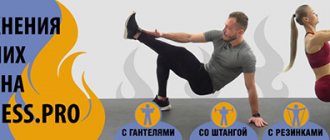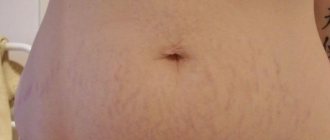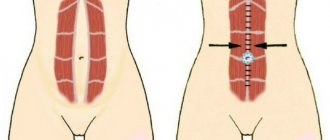Author: Tkachenko Sergey - master of sports in bodybuilding | more details >> Master of Sports of Ukraine in bodybuilding, coach. Finalist of the IFBB European Championship Moldova, Chisinau 2013. Champion of Ukraine in the category up to 70 kg. 2011. Multiple winner of the Ukrainian championships in bodybuilding and bench press. Senior moderator of our site.
Place in the author rating:
5
(become an author)
Date:
2018-10-11
Views:
15,829
Rating:
5.0
| All articles by the author >> | Medals articles >> |
Articles are loading...
Measures to combat diastasis of the rectus abdominis muscles after childbirth
https://zayplyushki.ru/wp-content/uploads/2013/10/postnatal-exercise-start-position-621×351.jpg Unfortunately, diastasis does not disappear on its own, and only increases in size over time. A good effect will be observed from special physical exercises that are aimed at strengthening the abdominal muscles. With the 1st degree of diastasis, you can only get by with exercises; with the third, you cannot do without surgical intervention.
With diastasis, it is very useful to do abdominal retractions; you can do this simple exercise at any time of the day (while walking, feeding, etc.). Pull your stomach in and hold this position for 30 seconds. The second simple exercise that effectively helps fight diastasis: lying on your back, raise your head and shoulders and hold yourself in this position for 25-30 seconds. Repeat 25 times.
Other exercises to eliminate diastasis are based on strengthening the deep transverse abdominal muscle, which from the inside encircles the back and abdomen like a corset. Strengthening the deep transverse muscle will help keep the abdominal wall from protruding and remove muscle diastasis. Exercises on the superficial abdominal muscles for diastasis are more harmful than beneficial. Also contraindicated are exercises with lifting the body and twisting elements, during which the abdomen is inflated. Such exercises will lead to an increase in diastasis!
You can reduce diastasis with the help of an effective and simple complex based on Pilates. Pilates is a special system of exercises based on stretching and strengthening the muscles of the body without impact. Pilates is especially recommended for women with back problems.
When performing exercises, keep your stomach pulled in and breathe through your chest without involving your stomach.
Set of exercises
The set of exercises outlined is intended for women experiencing diastasis of the rectus abdominis muscles. These exercises help strengthen the muscle corset and bring the longitudinal abdominal muscles closer together.
Vacuum. Stand straight, tilt your chest forward slightly (bending slightly). Exhale completely. Inhale and draw your stomach in, as if you are trying to pull it towards your spine. Hold this position for 10 seconds, then exhale and relax. Take several quiet inhale-exhale cycles and perform the exercise 5 more times. Before the exercise, you should not drink or eat for at least 1-2 hours.
How to make a vacuum
Interesting: How to do a belly vacuum for a thin waist
- Incomplete twisting. This exercise is similar to the diastasis test. Lie on your back with your legs bent. Hands at your sides, lower back clearly fixed on the floor. Exhale and lift your upper torso, including your arms. Hold this position for a couple of seconds, lower yourself back to the surface, inhale and relax. Do it 5 times.
- Bridge. We remain in a lying position with knees bent. Now we raise the pelvis so that the legs, hips, stomach and chest form a straight inclined line. Lock in this position for 2 seconds and lower your pelvis to the floor surface. Relax your muscles. Repeat 7 times.
- Bicycle variation. We again take a lying position. The knees are still in a bent position. Bring one knee toward your chest and straighten your leg up. Then bend your knee back and place your foot on the floor. Repeat with the opposite leg. Do 10 times for each.
- Straight line. Now take the “on all fours” position. In one motion, straighten your left leg back and extend your right arm forward. So that they form an even straight line with the back. Hold for 2 seconds and lower them back to the floor surface. Do the same with the opposite leg and arm. Number of repetitions: 10 times on each side.
Cat. Stay on all fours. Leaning on your hands and knees, arch your back slightly and at the same time tighten your stomach. Hold for a couple of seconds. Then bend in the opposite direction with a not too large amplitude - without relaxing the abdominal muscles and keeping it taut. Return to the starting position. Do the movement 4 more times.
Cat
Twisting with your knees. Lie on your back again with your knees bent. Keep your stomach tucked and your arms extended to the sides. Bend your knees to the left - twisting at the abdomen and waist. At the same time, the back and shoulder blades seem to be “glued” to the floor. Then return to the starting position and twist in the other direction. Do 5 times on each side.
Set of exercises
Interesting: Lower abs exercises for girls
Perform this workout regularly - 2-3 times a week. And within a couple of weeks you will notice the results. With the help of simple static exercises for women and following the recommendations, you will be able to cope with this problem in a short time - to forget about diastasis of the rectus abdominis muscles forever and gain beautiful shapes.
httpv://www.youtube.com/watch?v=embed/rSGH98Mvzww
Have you experienced diastasis of the abdominal muscles?
Diastasis - video exercises
All of the above exercises for diastasis are simple, but quite effective. If you do them regularly at least 3 times a week. Plus, to all this, adhere to a balanced fractional diet.
Do at least short light cardio several times a week. The result can be seen after 1.5-3 months for girls with stage 1 diastasis. And after 8 months for girls with 2nd and 3rd stages of diastasis. The main thing to remember is the regularity of training and the correct technique for doing the exercises.
I hope most likely I was able to answer all the questions and now you know. That a small natural diastasis after childbirth is a normal phenomenon that can be combated with specially selected exercises. You also learned how to determine whether you have diastasis recti or not.
If you still find it in yourself. I hope that the above exercises for diastasis will help you reduce its size and return your belly to its pre-natal state.
You also learned how to determine whether you have diastasis recti or not, and what to do if you do find it in yourself. I hope that the above exercises for diastasis will help you reduce its size, as well as return your belly to its pre-natal state.
You also learned how to determine whether you have diastasis recti or not. And what to do if you still find it in yourself. I hope that the above exercises for diastasis will help you reduce its size and return your belly to its pre-natal state.
- video
- women's workout
- women's workout at home
- Fat burners
- Diseases
- Techniques
- men's workout
- news
- reviews
- Nutrition
- program
- Miscellaneous
- Recipes
- sports nutrition
- workout
- Exercises
- Pharmacology
- Physiology
Dynamic exercises for diastasis:
The second group of exercises are dynamic, you can move on to them after mastering the first group.
- "Slide". It is performed in a lying position, with the feet and palms pressed to the floor. As you exhale, the pelvis rises up so that the hips, stomach and chest form a straight inclined line - a slide.
- "Butterfly". From the same position as in the “slide,” one leg is raised at a right angle and held in that position. The arms are held parallel to it and perform movements as if they were wings that a butterfly flaps, with the greatest possible amplitude. Then the exercise becomes more complicated - both legs are held at a right angle.
- "Pedal". In the same starting position, one leg rises up and straightens, as if pressing a pedal.
- "Bridge". Performed from a standing position on all fours, the opposite arm and leg alternately rise up, forming a straight line - a bridge.
Self-diagnosis of diastasis
If you suspect you have diastasis, we suggest you perform a self-diagnosis using video and record the results. To record, you can use the table in the infographic below or any medium convenient for you.
Diastasis is measured using three parameters:
Divergence length
Measure how many centimeters the muscles extend up and down from the navel
Divergence width
How many centimeters are there between the muscles above the navel and below the navel?
Finger depth
Evaluate how much your fingers sink when performing the test. During the recovery process, you will learn to engage the transverse abdominis muscle and the depth of immersion of your fingers during the test will become less.
During each test, observe the following aspects:
- Assess whether you experience pain in the pubic symphysis (the joint of the pubic bones).
- Try to feel the boundaries of the muscles along the middle of your abdomen and evaluate whether it is a soft tear or a clear separation of the muscles.
- See if you see a bulge or ridge.
- Listen to the sensations - do you experience discomfort in the pelvic floor area (involuntary release of urine, release of gases, air from the vagina).
| If something alarms you while performing these points, you should consult with your doctor to fully assess the condition of the abdominal cavity and/or pelvic organs before starting a cycle of exercises to correct diastasis. |
The video of the self-diagnosis test can be viewed below:
Self-diagnosis
How can you tell if you have diastasis? You need to lie on your back, bend your knees, feet on the floor. Place your left hand under your head, and place your right fingers parallel to your waist at navel level. Now you need to raise your head until you feel the tension in your abdominal muscles.
With your fingers you need to feel the midline of the abdomen along the entire length and understand whether there is a “cleft” between the muscles. If the gap cannot be felt, then there is no diastasis. If, on the contrary, a depression is felt, then muscle divergence is present.
When can you start doing exercises to treat diastasis recti?
Have you or your doctor diagnosed abdominal muscle diastasis? This is unpleasant, but fixable. The main thing is to tune in to daily activities and enjoy them. To determine when and what exactly you can do, you need to understand what degree of disease you have.
Diastasis has three stages of progression:
- The discrepancy between the muscles is up to 5 cm. This is the mildest degree of the disease and can be corrected quickly and painlessly. As a rule, it does not affect the well-being and shape of the abdomen.
- The discrepancy is more than 5–7 cm. At the second stage, the abdominal muscles become more relaxed and sluggish, a vertical hollow may be noticeable on the abdomen, and the abdomen itself is more flabby, as if you cannot draw it in. This can affect the functioning of internal organs and cause discomfort.
- The third degree is the most difficult in terms of well-being, appearance and treatment. Muscle discrepancy of more than 7 cm provokes various complications in the functioning of the body caused by displacement of the abdominal organs.
Also, the time to start training depends on the method of delivery. During natural childbirth, the integrity of the muscles is not compromised, so you can start exercising earlier than after a caesarean section.
The main rule is to not put anything off for later. You can begin to restore your abdominal muscles almost immediately after natural childbirth. If you have had a caesarean section, it is best to wait at least 4-6 weeks for the stitches in your uterus and abdominal wall to heal completely.
After childbirth, almost every woman experiences a discrepancy between the abdominal muscles of 3 to 5 cm. This is normal! While doing the exercises, don’t forget to feel the “gap” between these muscles with your fingers once or twice a week to monitor your progress. The narrowing of the distance between the muscles occurs in different women in their own way. This depends on many factors and can take from three months to a year. This is for the first degree of diastasis. With the second, recovery takes longer, but complete recovery is also possible. And the third stage cannot be corrected with the help of exercises, this is a serious violation of the integrity of the ligaments, and only a doctor should control the treatment, prescribe procedures and exercises.
Over the course of several months, the program will change, the exercises will become more and more energetic.
Required training intensity to treat diastasis
During the first time after the birth of a child, exercises should be performed in a calm, gentle manner. The frequency of repetitions can be gradually increased from 6 to 20 times over three to four weeks.
For women in the postpartum period, especially those who are breastfeeding, it is important to maintain a rest regime and try not to overexert yourself. Otherwise, your activities may cause harm instead of restoration and recovery.
Basic principles of classes:
- You should not feel pain, except for physiological pain caused by contraction of the uterus, sutures, etc. That is, the pain should not intensify during exercise.
- If you feel lightheaded, dizzy or anything like that, stop the activity immediately!
- Don’t put any effort on yourself, forcing yourself to do the exercises with all your might; it’s better to postpone it until the next day.
- Protect your body from excessive tension; the muscles must work normally so as not to damage ligaments, blood vessels, and sutures that have not yet recovered after childbirth.
In order to perform all the exercises efficiently, you must feel cheerful and rested. You should not exercise if you are unwell or feel unwell. The frequency and intensity of training should increase gradually. Everything here is very individual - age, weight, chronic diseases, the nature and course of childbirth affect your well-being.
Where is the best place to exercise?
The answer to this question is: everywhere! There are activities that can be performed in combination with visiting the clinic or going for a walk, feeding the baby and preparing lunch. From the outside, no one will understand that you are doing an exercise.
Of course, some sets of exercises can only be performed at home or in the gym. But not every mother will find the time and desire to visit him. In addition, it is easier to find time for training at home, and at the same time involve your baby in this activity. It will be interesting for him to lie next to his mother and see what she is doing that is so interesting.
If you live outside the city or have a summer house, you have the opportunity to train in the fresh air. Of course, in warm weather!
There are special exercises for the pool, but they can also be done in a regular river or lake. And it will be invisible to others.
How to determine diastasis after childbirth
Many women, having heard and read enough scary stories about the problem of almost all pregnancies - diastasis, try to find signs of muscle discrepancy on their own. In most cases this is possible. So, after childbirth, how to determine diastasis?
- An excessively convex or, conversely, located in a fossa navel.
- Big belly. Especially after a lot of time has passed after the baby is born. If a woman was plump before giving birth, then a bulging belly may not indicate diastasis.
- Frequent.
- Lumbar pain is also a common symptom of diastasis.
Test
Obviously, many symptoms do not allow self-diagnosis. Moreover, much depends on the stage of muscle divergence. It depends on how much the connective tissue of the midline (white) line is stretched. Therefore, for self-diagnosis, it is best to resort to a simple test.
To carry out the test you need:
- Lie on the floor or other flat surface. A sofa or bed with a soft, heavily sagging mattress is not suitable for this purpose.
- Bend your legs, bringing your heels toward your buttocks.
- Place 1 hand behind your head.
- Place your right hand on your stomach near the navel. Mentally dividing the stomach into 2 halves - right and left. Draw exactly in the middle. A depression should be visible in the navel area. Even if nothing is clearly noticeable, feel the skin, you should feel a depression. Ligament dehiscence usually occurs in the lower part. Those. the fossa should be visible at the location of the navel itself or slightly below it.
If the discrepancy is clearly expressed, diagnosis can be carried out with both hands. Simply, lying on your back, lower your hands to your stomach and gradually begin to move them along the center line of your abdomen in the navel area.
Provoking factors
Bearing a fetus itself, as mentioned above, is a factor that provokes diastasis. Since the load on the abs seriously increases during pregnancy. Large pregnancies carry more risks. The same goes for the birth of twins. The greater the load on the muscles and the less they are ready for it, the higher the likelihood of unpleasant consequences.
Dysplasia (weakness of connective tissue) is often congenital. Moreover, this problem usually manifests itself not only in this place, but throughout the body. People with weak connective tissue often also suffer from varicose veins, hemorrhoids, and hernias.
Stages of diastasis
Diastasis stage 1 is a slight expansion of the white line of the abdomen, which practically does not visually affect the shape of the abdomen (divergence of the rectus abdominis muscles up to 4-5 cm).
Diastasis stage 2 – separation of the rectus abdominis muscle in its lower section. At this stage, a protruding tummy is already noticeable, especially in its lower part (the divergence of the rectus abdominis muscles is up to 7-10 cm).
Diastasis stage 3 – separation of the rectus abdominis muscle, both in the lower and upper sections. This already significantly affects the shape of the abdomen, plus it can cause the appearance of an umbilical hernia (divergence of the rectus abdominis muscles up to 15 cm).
Types of diastasis
With the first stage of diastasis, you can very quickly and without surgical intervention return the prenatal shape of the abdomen, especially if the girl was involved in sports before giving birth and during pregnancy.
If the girl has stage 2 diastasis. Then special abdominal exercises + proper nutrition will help her significantly reduce the size of the diastasis within 7-10 weeks. What if the girl has stage 3? Then, most likely, it will not be possible to get rid of diastasis so easily. Perhaps it makes sense to resort to surgery and do an abdominoplasty. But even such a radical method does not always promise to return you to a 100% flat stomach, and the cost of this procedure is not the cheapest... Therefore, here the choice remains with the woman and depends on her financial situation and the degree of her despair.
diastasis - surgery
You may also be interested in the article: how to get rid of visceral fat
Visceral fat | how to measure and get rid of it
Static exercises for diastasis:
The listed exercises are static; you can begin to master them a month after giving birth.
- "Sticky belly." As you inhale, the anterior abdominal wall draws inward and remains in this state for as long as possible. Then, as you exhale, your stomach relaxes. This exercise, like the basic one, is performed standing.
- "Incomplete rise." To perform this exercise, you need to lie on a hard surface, bend your knees and press your feet and lower back to the floor. If your lower back does not fit tightly to the floor, you can place a pillow or bolster. We place our hands behind our heads, but do not help with them. As you exhale, your shoulders rise and your stomach tightens. This position is held for several seconds, then the stomach relaxes and the shoulders drop. There is no need to hold your breath during abdominal tension; it should be calm.
- "Springboard". This exercise is performed in the same way as the previous one, with the only difference that as you exhale, the legs are raised. They form a kind of springboard, which must be held for several tens of seconds, without slowing down your breathing.
- "Corner". This exercise combines the “partial lift” and “springboard” described above - the shoulders and legs are raised at the same time.
Diastasis recti exercises for women
If a problem arises, the correct selection of daily exercises will quickly tone the anterior abdominal wall and strengthen the rectus abdominis muscles. Training should be leisurely and careful so as not to cause complications and deterioration of the condition. It is not enough to just start pumping up your abdominal muscles, because this is fraught with aggravation of the situation. The set of exercises is relevant only for mild diastasis. In more severe situations, surgical treatment is required.
Abdominal retraction
This is one of the most effective exercises for diastasis. It perfectly stabilizes the core muscles and tones the abdominal wall. The execution algorithm is as follows:
You need to lie on your back and bend your knees under you. Breathing is calm and even. Perform abdominal retraction in a relaxed state. The second step is to draw in the abdomen in the lower abs
You need to make maximum effort to create a feeling of “sticking” your stomach to your back. It is important to concentrate only on the lower abdomen, without affecting the upper abdomen. Static concentration time is within 10 – 30 seconds. Next, you need to exhale smoothly and relax.
The recommended frequency of execution is three times a day, 10 times.
Pelvic tilt
This is a more difficult option for a beginner
The difficulty of the exercise lies in the ability to focus attention on the pelvic muscles without including the buttocks in the work. The execution steps are as follows:
- You need to lie on your back and bend your knees.
- The second step is to place your palms on your lower abdomen while simultaneously tensing your abdominal muscles.
- Breathing needs to be stabilized. The pelvis tilts upward until the lower back touches the floor (the arch in the back when lying down should disappear). Do not strain other parts of the body.
- The time of static position holding is up to 10 seconds.
The recommended number of approaches is up to 5.
Side plank
This option is well suited if you have diastasis. Execution steps:
- Stand facing the wall, leaning on straightened arms.
- Next, you need to tense your abs while simultaneously pulling in your abdominal muscles.
It is recommended to do 10 repetitions in one approach.
Reverse plank
This is a good option for expanding your arsenal of exercises. The benefit of the reverse plank is static strengthening of the lower back, which is also beneficial for mothers. The execution algorithm is as follows:
- You need to lie on your back, place your legs hip-width apart, and place your feet on the floor.
- The arms are extended along the body. Next, you need to pull your shin towards your buttocks so much that you can reach your heels with your fingers.
- As you inhale, lift your hips up, and as you exhale, lift your body and straighten your chest.
This needs to be repeated 5–10 times in a row.
Hula Hup
You can spin the hoop if there are no gynecological contraindications. If you have uterine fibroids, cysts or endometriosis, hula hoop is contraindicated. The weight of the projectile should not exceed 1.5 kg. The hoop engages the oblique abdominal muscles, which also help combat aponeurosis separation. It is necessary to twist the hula hoop alternately, in different directions. The duration of the lesson is about half an hour a day.
Crunches with a towel
Traditional abdominal crunches are not recommended if you have diastasis. An alternative option for performing the exercise is towel crunches. It is necessary to wrap the body in a towel and grasp the opposite edges of the fabric with your hands. When performing twisting, your hands simultaneously pull the ends of the towel in different directions. The number of repetitions is no more than 5-10 at the initial stage.
Lifting the pelvis while lying down
The second name of the exercise is the gluteal bridge. The exercise is performed in a lying position on your back. Feet are placed hip-width apart with the feet fully resting on the floor. At a calm pace, you need to raise your pelvis, squeezing your buttocks at the top. It is necessary to monitor the speed and working amplitude. A sudden descent may cause excessive stress on the lower back, which is not recommended after a recent birth. The gluteal bridge tones the buttocks and pelvic muscles and helps restore the aponeurosis.
Prohibited exercises
What not to do when separating the rectus muscles after childbirth:
- Lie on a fitball.
- Do any exercises in a knee-elbow position.
- Tighten your abdominal muscles with crunches, planks or push-ups.
- Practice elements of yoga that use abdominal breathing techniques.
How to determine diastasis recti
A simple test that involves measuring the distance between the inner edges of the rectus abdominis muscles will help determine the presence of diastasis at home. Lying on your back on a hard surface, bend your knees. One hand is placed under the head, the other on the line above the navel. In a relaxed state, the chest is lifted off the floor, and the fingertips are immersed in the stomach. The size of the dip allows you to determine the severity of diastasis of the rectus abdominis muscles. It is more noticeable between the navel and the xiphoid process of the sternum. Doctors use a similar option for diagnosing diastasis; instrumental and hardware examinations are prescribed if the patient is obese, has a suspected hernia, or prolapsed organs.
Diagnostics
Diastasis of the rectus muscles is accompanied by a number of characteristic signs, so it is easy for a doctor to determine the diagnosis. The main methods for confirming diastasis are examination and palpation of the inner edges of the rectus abdominis muscles.
The patient is asked to do the following:
- lie on your back on a hard couch;
- bend your knees, rest your feet completely on the surface;
- tighten your abdominal muscles.
The doctor feels the protruding ridges along the edges of the abdominal muscles and measures the amount of their divergence with a ruler.
Measuring the width of the discrepancy helps to clarify the degree of diastasis. The initial stage is characterized by a slight expansion in the navel area, the deviation does not exceed 5 cm. The changes practically do not affect the shape of the abdomen. With stage 2 pathology, the defect increases to 7-8 cm. The abdominal cavity begins to bulge from below. A white line width of more than 8-10 cm indicates a severe form of diastasis of the rectus muscles. The abdomen becomes saggy, and there is a high probability of developing an umbilical hernia.
A pronounced diastasis is noticeable in a standing position in the form of a vertical defect between the rectus abdominis muscles. If a person is asked to tense his abdominals, a longitudinal keel-shaped protrusion is noted.
This method of diagnosing diastasis is ineffective if the patient is overweight; the doctor prescribes an ultrasound. Sonography visualizes the thinning of the abdominal line, clarifies the amount of stretching, determines the presence of a hernia, prolapse of internal organs. In rare cases, radiography is performed. Based on the CT results, the condition of the abdominal cavity is assessed and diastasis of the rectus abdominis muscles is differentiated from pathologies that have a similar clinical picture.
httpv://www.youtube.com/watch?v=embed/fheZTfekbyM
Additional clinical manifestations
The patient's main complaint in the initial stage is protrusion of the abdomen in the area of the white line. Men note a lack of definition during constant training to work their abdominal muscles. Internal organs are not affected by diastasis, so the stomach will hurt only in severe cases, accompanied by complications. In stage 3, people often complain of the following symptoms:
- dyspepsia (nausea, bloating, constipation);
- feeling of heaviness in the legs when walking;
- muscle atrophy in the problem area;
- lumbopelvic pain.
When the rectus abdominis muscles diverge during pregnancy, girls notice the defect in the postpartum period. They often complain of urinary incontinence when coughing or sneezing.
Suspicion of the development of diastasis in young athletes arises when MARSS syndrome, flat feet with valgus deformity, and frequent ankle subluxations are detected.
Diastasis during pregnancy
In pregnant women, as the fetus grows, the uterus also increases in size, which increases pressure on the abdominal wall, stretching the connective tissue (linea alba), which, under the influence of the hormone relaxin, becomes softer and more elastic, which is one of the reasons for the appearance of Diastasis. The hormone relaxin is secreted by pregnant women in order to make their ligaments and joints more mobile, which helps women give birth more easily, but at the same time it makes the connective tissue that makes up our white line of the abdomen overly elastic. It turns out that the hormone relaxin contributes to the appearance of diastasis in pregnant women.
Diastasis of the rectus abdominis muscles
These two factors - increased pressure of the uterus on the abdominal wall and excessively elastic connective tissue - are the main reasons for the appearance of diastasis after childbirth.
But in fact, there is no need to immediately fall into despair and postpartum depression if you discover diastasis immediately after childbirth. This phenomenon is absolutely normal. Most mothers who have given birth have a discrepancy in the rectus abdominis muscles, which normally should not exceed 2 cm. That is, if the width of your linea alba within 15 months after birth is 2-3 cm, then this is absolutely normal (we have already identified the reasons) . During this period, you just need to do strengthening exercises for the abdominal muscles, which I will write about below, and just wait for the muscles to tone up and the distance to shorten on its own.
If the muscle discrepancy exceeds more than 3 cm (3-4 fingers can easily fit between the abdominal muscles that move apart), then you should take a more serious approach to solving this issue and use the exercises below to reduce your diastasis, since there is a high probability that he himself will not disappear so easily.
- Proper nutrition for athletes | 4 harmful myths about nutrition.
- Workouts for Anabolic Steroids | Harsh reality
- Varicose veins and bodybuilding | Find out all about it. Train smart.
- Coronavirus: China bans 11 million residents from leaving city
- Benefits of gelatin | How to take gelatin for joints
A set of exercises for diastasis of the rectus abdominis muscles
We will present only 4 simple and effective exercises, the regular implementation of which will allow you to get rid of diastasis. Before starting classes, consult your doctor to identify possible contraindications. Typically, such a complex can be performed 2-4 weeks after birth, but it is better if the doctor sets the start time for training.
For nursing mothers, there is a rule - all exercises are performed either immediately after feeding, or 1 hour before breastfeeding.
1 exercise
Lying on your back, legs bent at the knees, arms along the body. Slowly lift your pelvis off the floor, starting at your tailbone. The movement is smooth, literally “vertebra by vertebra.” At the same time, pull your tailbone up and the top of your head forward. Don't forget to breathe only through your chest. Stop when your pelvis, knee and shoulder are in line, inhale, and begin to lower your spine to the floor. This exercise perfectly stretches the spine, strengthens the abs and thigh muscles. Repeat 4 times.
Exercise 2
The starting position is the same. As you exhale, bend your right leg at a right angle. As you inhale, raise your arms (palms facing the floor) and make 5 active movements simulating hitting water. As you exhale, make 5 active movements with your palms facing up. Repeat 10 times for each leg.
This exercise warms up the abdominal and arm muscles and strengthens the transverse abdominal muscle.
As you practice, the exercise can be made more difficult by lifting 2 legs at once, bent at a right angle. In the future, you can keep your legs straight by squeezing a small ball between them.
Exercise 3
The starting position is the same. We press the lower back to the floor as much as possible (you can place a low pillow or a folded towel). Raise the right shin (knee bent) up to a right angle. As you exhale, straighten your entire leg, while pulling in your stomach as much as possible. We pull the top of the head up, the pelvis is level. While inhaling, we return to the starting position. We change the leg. Repeat 10 times for each leg. All exercises are performed slowly and smoothly, as if in slow motion filming. Control your breathing and muscle function.
This exercise specifically strengthens the deep transverse abdominal muscle.
To make it more difficult, you can lift both legs at once, but as you exhale, straighten one leg and bring the other leg towards you with your knee to balance the pelvis.
Exercise 4
https://zayplyushki.ru/wp-content/uploads/2013/10/2013-10-10-15-27-32.jpgStarting position on all fours, palms directly under the shoulders. The stomach is tucked, the body is kept straight. Straighten your left leg as you exit until it becomes parallel to the floor. As you inhale, return to the starting position. Don't arch your lower back! The top of the head is pulled forward, the toe of the raised leg is in the opposite direction. Do 10 repetitions for each leg.
To complicate the exercise, simultaneously with raising your leg, raise your arm on the opposite side.
Health to you and your kids!!!
Abdominal diastasis training with different plank options
This complex is designed for a fairly advanced level. Of course, young mothers after the birth of a child are not in the best athletic shape.
You need to start doing the plank gradually with the simplest version of 3 approaches of 40-60 seconds. And then, as your muscles begin to strengthen, you can add more and more complex modifications to this exercise. And increase the time of the abdominal workout itself.
When performing the plank with diastasis, you need to follow the technique of doing the exercise and RETRACT YOUR ABDOMEN . Your abdominal muscles should not be relaxed even for a second! This is a very important point!
Notes on training for diastasis
You can perform abdominal exercises with diastasis 3-4 weeks after giving birth.
- All static abdominal exercises for diastasis
These exercises involve holding the abdominal muscles without moving for some time. Such exercises can also be ordinary twisting, but only those performed WITHOUT MOVEMENT OF THE BODY UP AND DOWN. For example, keeping the shoulders up IN STATICS and the HUNDRED exercise:
Training for diastasis: holding the abs in static tension
Do 2 approaches for 15-20 seconds.
Exercise HUNDRED
We perform these exercises from 40 seconds to 1-2 minutes in 3 approaches
- Kitty
Do 20-30 repetitions in 3 sets.
- Gluteal bridge
Do 3 sets of 15-20 repetitions.
This exercise strengthens the pelvic floor muscles well. You can perform it either in a simple version (two feet are on the floor) or in a complicated version (one leg is raised up or lies on the knee of the other). Perform 15 repetitions in 3 sets.
Gymnastic complex for the treatment of diastasis immediately after childbirth
Let's start with the exercises allowed immediately after childbirth. After a caesarean section, it is better to postpone them for several weeks.
Don't be afraid to do these exercises, they will just support your organs and muscles in a completely natural position, without putting any extra stress on them.
The first exercise is breathing
Lie on your back on the floor or hard sofa. Bend your knees, your heels resting on the floor. You can place your hands on your stomach. Inhale deeply through your nose, hold the air for 2-3 seconds and exhale through your mouth. As you exhale, pull in your stomach and hold for 2-3 seconds. Repeat 5-6 times to start. This will help your abdominal muscles contract faster. In addition, the exercise promotes overall relaxation of the body.
Breathing deeply out of habit may make you feel dizzy. It's not dangerous, just take a break between sets and breathe as usual.
After three to four days, increase the frequency of exercises by one or two daily. Try to increase the number of repetitions to twenty.
The second exercise is during feeding
Of course, you can do it just lying on the bed, whatever is comfortable for you. So, lie down on your side and bend your knees. We inhale, then exhale and draw in our stomach. In this case, you need to arch your lower back so that your back takes the shape of the letter C. We linger in this position for a few seconds, breathing through our nose. Then we relax, returning the lower back to its normal position. Start with six repetitions and work your way up to twenty.
This exercise can be made a little more complicated if you also pull your perineum in as you exhale. Then at the same time your abdominal, back and pelvic floor muscles will work and recover.
Both of these exercises are aimed at soft and natural recovery of the abdominal muscles. When performing them, keep in mind that you don’t need to pull in your stomach as hard as you can, but just enough so that you feel comfortable and not in pain. Over time, you will draw it in more and more, it will not cause you any difficulty.
Don't forget to do a diastasis test every week, feel the gap between your abdominal muscles. I have no doubt that by the fourth week after birth it will noticeably decrease.
Third exercise - four weeks after birth
This is a more complicated version of the first exercise, so after a caesarean section it can be performed no earlier than 8 weeks if you do not have any complications.
The starting position is the same, lying on your back with your knees bent. We draw in the stomach as we exhale, as we have already done. Then we squeeze our buttocks and smoothly lift our pelvis off the floor and lift it up. Only the shoulder blades remain on the floor. To begin with, we hold this position for 4–5 seconds. Try to increase the delay time day by day, bringing it to 10–15 seconds. Repeat six times. The number of approaches also needs to be increased, gradually increasing to 10–12 times.
The main mistakes when performing this exercise are arching in the lower back; it should not be there. From your neck to your tailbone, your body should be a straight line. Then not only the abdominal muscles will be involved, but also the muscles of the legs and back. When you feel the opportunity, complicate the exercise by retracting the perineum.
When you learn to draw in your stomach correctly and effectively, you will be able to do this no longer lying on the mat, but in any position and in any place. For example, sitting on a bench in the park while walking or in a store in line at the checkout. This is no less useful and almost invisible to other people, and it doesn’t waste your time. Such exercises can be done up to 200–300 times a day.
Basic Rules
What to do, how to help yourself when you discover this unpleasant phenomenon? Before we talk about the exercises that can and should be performed with diastasis in order to return the abdomen to its prenatal state, let’s consider the basic rules:
- In case of diastasis, classic usual abdominal exercises are contraindicated: lifting the torso from a lying position; as well as excessive stretching of the abdominal muscles: exercises on a fitball, deep deflections in the lower back.
- It is necessary to strengthen not the external abdominal muscles (the so-called cubes), but the internal abdominal muscles.
- Various types of crunches, cycling, push-ups, and heavy lifting are also contraindicated.
Not only will these exercises not bring any benefit, but they can significantly worsen the condition.
Summing up, general recommendations
As is clear from the description of all the exercises presented above, they are easy to perform and do not require special physical training or special conditions. They are quite easy to perform at home, in the gym, and some of them even while driving or in the office, and so on. The most important and key point is the correct execution, that is, the technique of performing the exercises. A prerequisite is to always keep your abdominal muscles tense, all tasks must be performed calmly and slowly, breathing should always be smooth and not falter, the whole range of exercises must be performed systematically, otherwise there is no point in dreaming of any results.
Do not forget that if the stage of diastasis is advanced (that is, a deepening, the distance between the rectus abdominis muscles reaches 10 cm or more), then such exercises will not be able to correct the situation. Having such a problem, you definitely need to consult a specialist, possibly even surgical intervention. In addition, the psychological factor also plays an important role, because the right fighting spirit and self-confidence are capable of much. For a woman who has become a mother and has gone through many trials, diastasis may seem like just a speck of dust, which will not be difficult to get rid of.
Causes of diastasis
Of course, diastasis cannot occur on its own. Its appearance is influenced by several factors:
- increased intra-abdominal pressure (lifting heavy weights, straining) which leads to diastasis.
- weakness of connective tissue, which is caused by diseases such as hernias, varicose veins, excessive mobility of joints and ligaments, etc. which also causes the appearance of diastasis.
- pregnancy. The main reason for the appearance of diastasis in women.
In this article, we consider diastasis of the rectus abdominis muscle, which is associated specifically with the last factor, which concerns almost all women - future and current mothers
Diastasis of the rectus abdominis muscles










